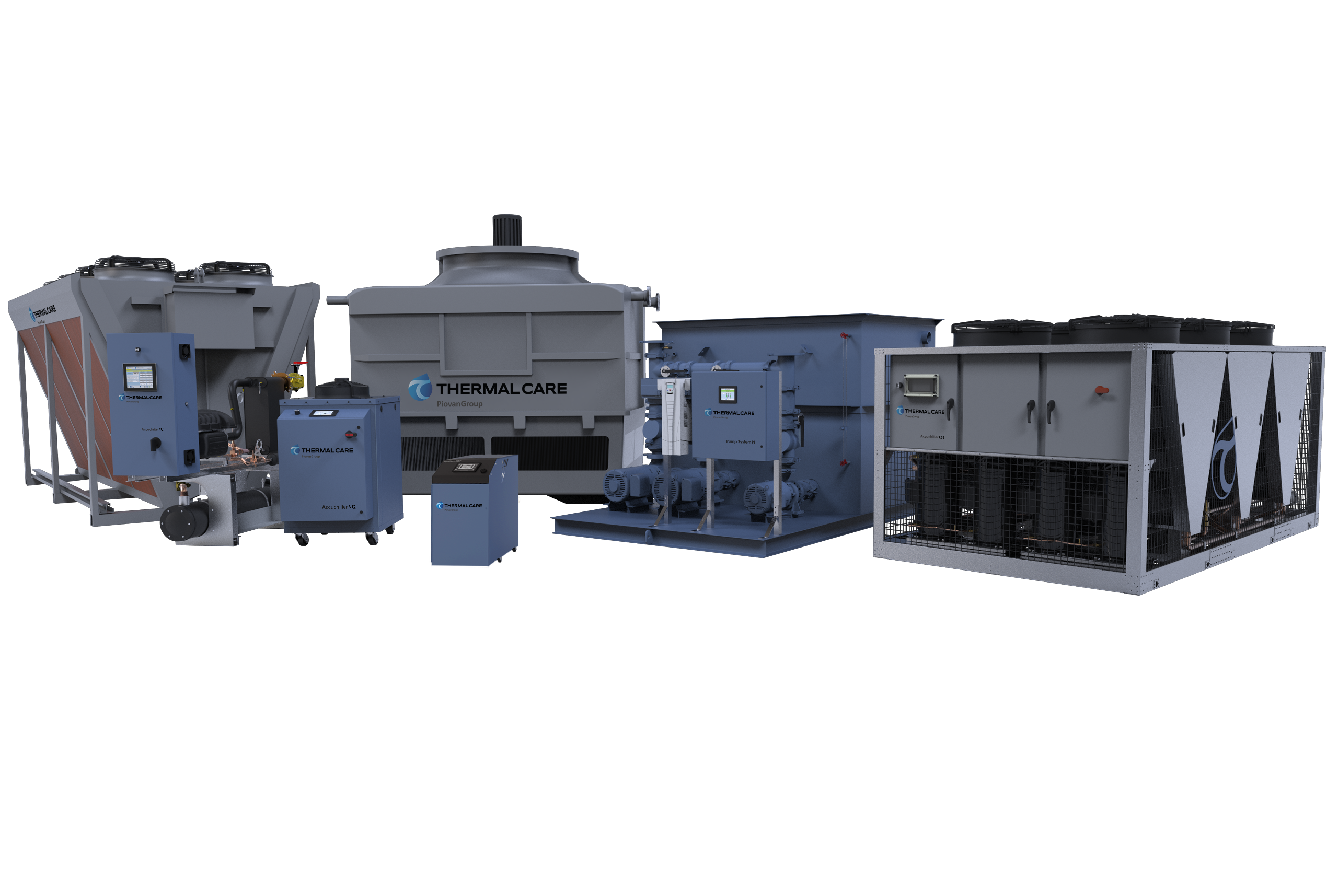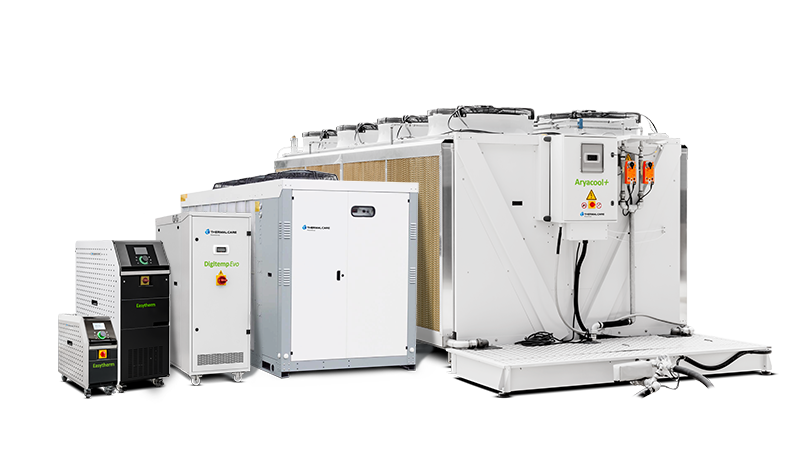How does a TCU work?
The two major components in a temperature control unit are a pump and a heater which are managed by a Programmable Logic Controller (PLC). A temperature setpoint is input into the controller. The pump continually circulates a fluid – most commonly water - from the TCU, to the process, and then back to the TCU. This is referred to as the temperature control loop or process loop. While the fluid is circulated through this loop, the controller will monitor input from a temperature sensor on the TCU’s return line. If the fluid is returning to the TCU lower than the setpoint, this means energy is being transferred from the fluid into the process. Therefore, the TCU is heating the system. The controller will activate the heater in the TCU to add more energy to the fluid. Conversely, if the fluid is returning to the TCU warmer than the setpoint, this means energy is being transferred from the process into the fluid. In this case, the TCU is cooling the system. The controller reacts to this situation by actuating the cooling valve.
Temperature
Temperature control units (TCUs) are relatively simple in their design and operation, but the impact they have on industrial processes can be significant. To understand this, we need to review the various components of the construction, how the units operate, and what factors to consider when selecting a design for a specific application.
While the basic design and function of temperature control units can be relatively simple, each aspect has a wide-ranging impact on the system overall.

Typical TCU showing the pump and heater tube
Indirect or Direct Cooling Operation
The TCU does not generate the cooling itself. Instead, it utilizes a cooling source to lower the process loop’s fluid temperature. Common cooling sources are a chiller system, a cooling tower system, or city water.
There are two configurations for the cooling operation – direct and indirect. The name refers to how the cooling source fluid interacts with the process loop fluid.
For direct injection cooling, when the cooling valve is opened, it allows the warm fluid from the process loop to escape from the system. This warm fluid can go directly to a drain or into a return line going back to the cooling source such as a chiller. The cooling source supply replaces the volume that released from the process loop. The cooler fluid is mixed directly into the warmer fluid of the process loop, which reduces the temperature of the system, achieving the desired cooling.
Indirect designs still use a cooling valve, but the process loop’s fluid is isolated from the cooling source fluid with a heat exchanger. The cooling valve controls the flow of the cooling source fluid through the heat exchanger. The warmer fluid transfers energy into the cooling source fluid thus achieving the required cooling.
There are pros and cons to each cooling style. Direct injection mixes the two fluids so contamination is a concern, but the energy transfer rate is not limited by a physical heat exchanger. Indirect cooling maintains separation of the fluids but is limited by the capacity of the heat exchanger. There are also implications for the maximum setpoint of the system because of pressurization requirements that make high temperatures possible.

Indirect cooling maintains separation of the fluids but has a more limited flow based on the capacity of the heat exchanger.

Direct Injection allows more flow but there is concern with contamination of the two fluids.
Solenoid vs. Modulating Valves
In both designs, the type and size of the cooling valves are critical for accurate, reliable control. Solenoid valves use simple open or close control. By contrast, modulating valves use a control signal to actuate the valve’s orifice over a range of values. The additional level of control with a modulating valve increases the precision of the cooling and in turn improves temperature stability in the system.
Selecting the right size of valve based on its Cv (valve characteristic) also influences the precision of the cooling operation. If a valve is too small it cannot achieve enough cooling, and the TCU will not be able to maintain its setpoint. Heat will build up, eventually forcing the system to shut down. When the cooling valve is oversized, an excess of warm fluid is released from the process loop and replaced by an influx of cold fluid. This drives the temperature far below the setpoint and reduces the TCU’s setpoint accuracy. Understanding your particular process cooling requirements can help you navigate these various design options.
Heating Function
The heating function of the TCU is a more straightforward process. An inline heater is installed as part of the process loop inside the TCU. These heaters are often high watt density, which refers to the heating element’s wattage compared to its surface area. High density heaters can impart more energy, more quickly than standard density heaters. Most commonly these heaters are made of Incoloy or sheathed in Incoloy. Incoloy is a superalloy or high-performance alloy. It is known for excellent resistance to corrosion and the ability to transfer heat. For TCUs, Incoloy is superior to copper, glass-lined or even ceramic heating elements because of its performance and long life.
TCU heaters are selected based upon their kilowatt (kW) rating. When determining what kW heater is needed for your application, the required time to heat up a process is one of the most important factors. Kilowatt is a rate, which means that the higher the kW, the shorter the heat up time. When using a TCU for a heating application, the process loop transfers heat to your application and returns to the TCU colder than the setpoint.
One of the most important considerations for the design of the TCU is the type of contactor used to actuate the heater. The controller on the TCU will cycle the heater on and off to maintain an accurate temperature. Traditional electromechanical relays (EMRs) are rated for a limited number of cycles before failure. These can fail in the on position, which would force the heater to stay on and drive the temperature up beyond maximum safe levels. For this reason, leading TCU manufacturers use solid state relays (SSR) in place of EMRs. The SSRs typically are rated for 100 times more cycles than EMRs. They are more expensive, but increased performance, reliability, and safety easily justify the cost.
Pump Size Selection
The last key component of a TCU is the pump used to circulate the fluid through the process loop. It is crucial to select the right pump for each application. There are a variety of pump sizes available to provide the right amount of flow at a required pressure. Different pump manufacturers have designs that achieve better efficiencies than others and generate higher flows with their specific grouping of the motor, impeller and volute. Simply assuming all 1 hp pumps are the same will create a scenario where the required flow rate is not achieved, or energy (and operating costs) are wasted because a 2 hp pump was installed when another manufacturer’s 1 hp design could provide the same performance. It is important to review the published pump curves for the various sizes available in TCUs.
The installation design also plays a role in the pump’s ability to achieve the required flow. The piping type, material and routing all affect the pump's operation by creating pressure losses in the system. The process loop design should minimize these losses when possible. This ensures the flow through the system is high enough and therefore turbulent. Flows are generally described two ways: turbulent or laminar. Lower flows are more likely to be laminar while higher flows are turbulent. Relating these types only to flow rate is a significant simplification of the concept. Laminar or turbulent flows are governed by a ratio known as Reynolds Number, which considers the density of the fluid, flow speed, and viscosity over a defined length.
A good example to help grasp the concept of laminar and turbulent flow is found with a faucet. When the faucet is barely turned on, the water coming out appears to move in smooth paths and is visually clear – this is laminar flow. As the faucet is opened further, the water becomes less clear and has irregular fluctuations – this demonstrates turbulent flow.
These concepts are important for TCUs because laminar versus turbulent flow directly affects the ability to transfer energy. The relationship is exponential so turbulent flow can have an order of magnitude improvement in energy transfer. This means that the TCU is much more effective at either heating or cooling as needed. A higher flow rate through the system also reduces the temperature differential from supply to return. This helps to create a more uniform temperature gradient through the process, which ultimately promotes consistent operation. The ability to achieve these flow rates is directly related to the pump. This is why the pump is such an important aspect of the design. It is the heart of the system and crucial for efficient and effective performance.

Two types of flow can occur inside a pipe or heat exchanger: laminar and turbulent. The higher the flow, the more likely heat transfer will occur.
Where are TCUs Used?
TCUs are used in a wide variety of applications and industries ranging from food production, chemical reactions, laser control, and plastics processing, just to name a few. Each requires specific considerations to determine what TCU design will best meet the needs of the system.
For example, some chemical reactions are temperature controlled by adding or removing heat. These reactions are often conducted in jacketed vessels with high pressure restrictions. A direct injection TCU adds the pressure generated by its internal pump on top of the pressure available from the cooling source. This could potentially damage the vessel if not considered during the design phase of the system.
Other applications regularly break into the process loop plumbing which introduces air each time. Some specialized designs might be needed to use a TCU for these applications. Nonferrous construction of the process fluid circuit could help avoid corrosion from rust, and a control feature known as automatic air purge can be included.
While the basic design and function of TCUs can be relatively simple, each aspect has a wide ranging impact on the system. The effects of each component’s design can lead to a number of benefits or potential issues for the system. It is always helpful to consult an expert application engineer to assist with the selection of design.




